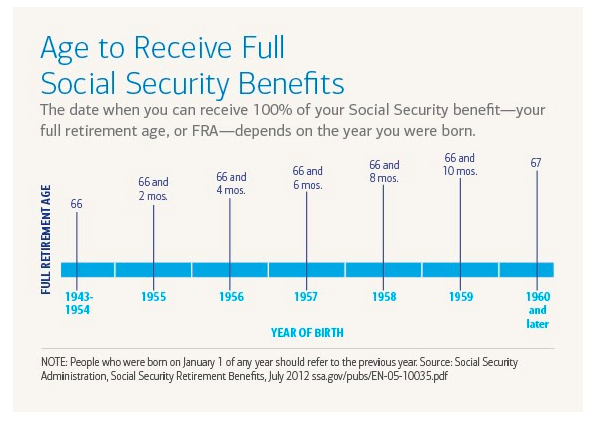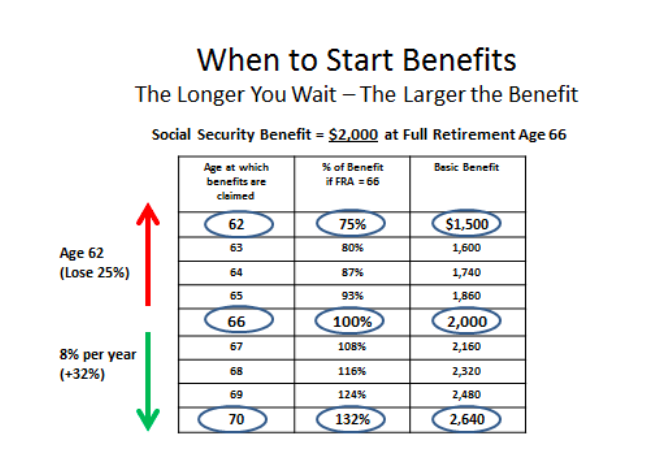
By Moe Ansari
Social Security is no doubt an important piece of your retirement income, but do you know how much you will receive? 86% of people don’t, (1) and what’s worse, 27% overestimate their benefit amount. (2) How can you plan for your retirement if you don’t know how much you will have to live on? That’s why it’s crucial for you to have a solid understanding of how your benefits work.
There are a number of decisions you will have to make regarding Social Security that can have a great impact on how much you will receive. That’s why we’re answering the five biggest questions that everyone has about Social Security and helping you learn how to maximize your benefits.
How Are Social Security Benefits Calculated?
Your Social Security benefits are calculated based on lifetime earnings. The Social Security Administration (SSA) calculates your benefit based on your 35 highest earning years, with a minimum of 10 years of work required to be eligible for benefits. If you have worked less than 35 years, then your earnings will be calculated with zeros for the remaining years. All past wages are indexed to today’s wages in order to accurately reflect wage growth.
Once your average monthly earnings for your top 35 years are calculated, a special formula is applied and the result is your primary insurance amount (PIA). The PIA is the benefit you are eligible to receive when you reach full retirement age (FRA).
The actual benefit that you receive may not be your PIA. Your PIA will be increased or decreased depending on when you choose to begin receiving benefits. Taking benefits before FRA will reduce your benefit and waiting until after FRA will increase your monthly benefit. Also, starting at age 62, your eligible benefits will receive regular cost-of-living adjustments.
Spousal Benefits
Married people are eligible for benefits based on their spouse’s work history. The spousal benefit is 50% of the working spouse’s earned benefit. In order to receive these benefits, the working spouse must be at least 62 and have already filed for benefits.
If you are divorced, you may also be eligible to receive spousal benefits based on your ex-spouse’s work history. Your marriage needs to have lasted at least 10 years, you must be divorced for at least two years, and you must still be single. In addition, you need to be at least 62 and not eligible for higher benefits based on your own work record. Unlike spousal benefits for married people, your ex-spouse does not need to have filed for benefits in order for you to claim them.
When Can Social Security Benefits Be Claimed?
You can claim your Social Security benefits anytime between age 62 and age 70. However, when you choose to collect benefits will impact the amount of benefit you receive.
Early Retirement
You can start receiving benefits as early as 62 but your monthly benefit will be lower than if you waited longer. Your basic benefit is reduced a fraction of a percent for each month you begin receiving benefits prior to full retirement age. Retiring early can permanently reduce your benefit by up to 30%.
Full Retirement Age
Your full retirement age (FRA) changes based on the year you were born. FRA is 66 for those born between 1943 and 1954 and increases by two months for every year after that you were born until it settles at age 67 for those born in 1960 or later. If you wait until you reach full retirement age to begin collecting your Social Security benefits, you will receive the full PIA that you have earned.

Delayed Benefits
If you’re still working or don’t need the money immediately, you can delay receiving your benefits. Your benefit will increase by 8% for each year that you delay, with a maximum possible increase of 32%. You cannot delay and increase your benefit indefinitely, though. Once you reach age 70, you are required to file for benefits and can no longer increase your benefit by waiting.
When Is The Best Time To Claim Social Security Benefits?
While you are working, you can increase your future Social Security benefits by earning higher wages. Once you stop working, though, the only influence you have over your benefit is when you begin to take it. Your timing has a great impact on the amount of the benefit you will receive and should be carefully considered.
Social Security Statement
An important document that you will reference during the decision-making process is your Social Security statement. The SSA mails these statements out from time to time, but you can also access the same information by setting up an account on their website.
The statement will tell you your:
- Estimated benefit if taken at age 62
- Estimated benefit if taken at FRA
- Estimated benefit if taken at age 70
- Estimated disability benefit
- Estimated family and survivor benefits
- Medicare information
- Earnings history
All benefit amounts listed are estimates and subject to change. They are calculated based on your date of birth and future estimated taxable earnings.
It is important for you to review your earnings history and check for accuracy. Your benefit is calculated based on those numbers, so any mistakes can affect your benefits. You should correct any errors as soon as possible.
Deciding When To Claim Benefits
Your Social Security benefits are calculated using complex actuarial equations based on life expectancy and estimated rates of return. They are not designed to encourage early or late retirement. If you live as long as anticipated, the total amount you receive over your lifetime should be about the same whether you claim it at age 62, age 70, or sometime in between. You will either receive the money as a smaller monthly payment over a longer period of time or a larger monthly payment over a shorter period of time.
The best time for you to claim your benefits depends on your personal situation and health. If you expect to live longer than average, your overall lifetime benefit will be greater if you delay claiming your benefits to increase your benefit amount. If the opposite is true and you see little chance of making it into your mid-80s, you would receive a greater lifetime benefit by taking it sooner, even though it would be a smaller monthly payment.

Once you decide when you want to start receiving benefits, remember to complete your application three months before the month in which you want your retirement benefits to begin.
How Can Married Couples Maximize Benefits?
Because married people have the ability to receive their own benefit or a spousal benefit, they have more to consider when filing for benefits. With the right strategy, married couples can maximize their benefits.
In the majority of cases, the lower-earning spouse should begin collecting benefits early while the higher-earning spouse waits as long as possible. That way, you can access the lesser benefit while maximizing the higher benefit.
Often, it is the husband with the higher benefit and the wife with the lower one. Women also tend to live longer than men. By following this strategy of waiting as long as possible to claim the higher benefit, you not only maximize the husband’s retirement benefit for use while he is alive, but it also maximizes the wife’s survivor benefit when he passes away.
Restricted Application
While it used to be a popular claiming strategy, the Restricted Application is now only available to those who turned 62 before January 1, 2016. If you were born before 1954, you can receive a spousal benefit at FRA even if your spouse is not collecting benefits. That way, you can begin to receive spousal benefits even while letting your spouse’s regular benefit continue to grow until age 70.
How Does Working Affect Benefits?
Working does not affect your benefits once you reach FRA, but it does before that. Only earned income, such as wages and self-employment earnings, affect your Social Security benefits. Income from investments, pensions, and annuities do not affect Social Security benefits.
When you are under FRA for the whole year, your Social Security benefit is reduced by $1 for every $2 you earn over $18,240. In the year that you reach FRA, your benefit is reduced by $1 for every $3 you earn over $48,600. Once you reach FRA, your benefit is no longer reduced no matter how much you earn.
Work With An Experienced Professional
Depending on how much you have in savings, when and how you claim your Social Security benefits could very well be the most important retirement decision that you make. Because of the significance and complexity of this decision, it is a good idea to consult with a financial professional before beginning the process.
Strategizing with an experienced financial advisor will give you confidence knowing that you are doing everything you can to maximize your benefit and help you fit Social Security into your overall retirement plan. Call 800-388-9700 or email investments@compak.com to schedule a free consultation and start making the most of the financial resources available to you!
The information in this discussion is current (and, we believe, accurate) as of the publication date but things can change. Be sure to talk with your financial and tax advisors about your own situation—ideally, well in advance—when making decisions about your Social Security benefits.
About Compak Asset Management
Compak Asset Management is an independent wealth manager providing custom-tailored portfolio and retirement solutions. Founded in 1999 by Moe Ansari, we are a fiduciary dedicated to providing clients with some of the best advice, ideas, and products to enhance their lives. Compak’s customized solutions and experienced team combine to deliver world-class wealth management and tailored financial plans to meet our clients’ financial needs. To learn more about Compak, connect with us on LinkedIn or compak.com/contact.
_________
(1) https://www.fool.com/investing/2018/07/08/22-social-security-stats-that-will-blow-you-away.aspx